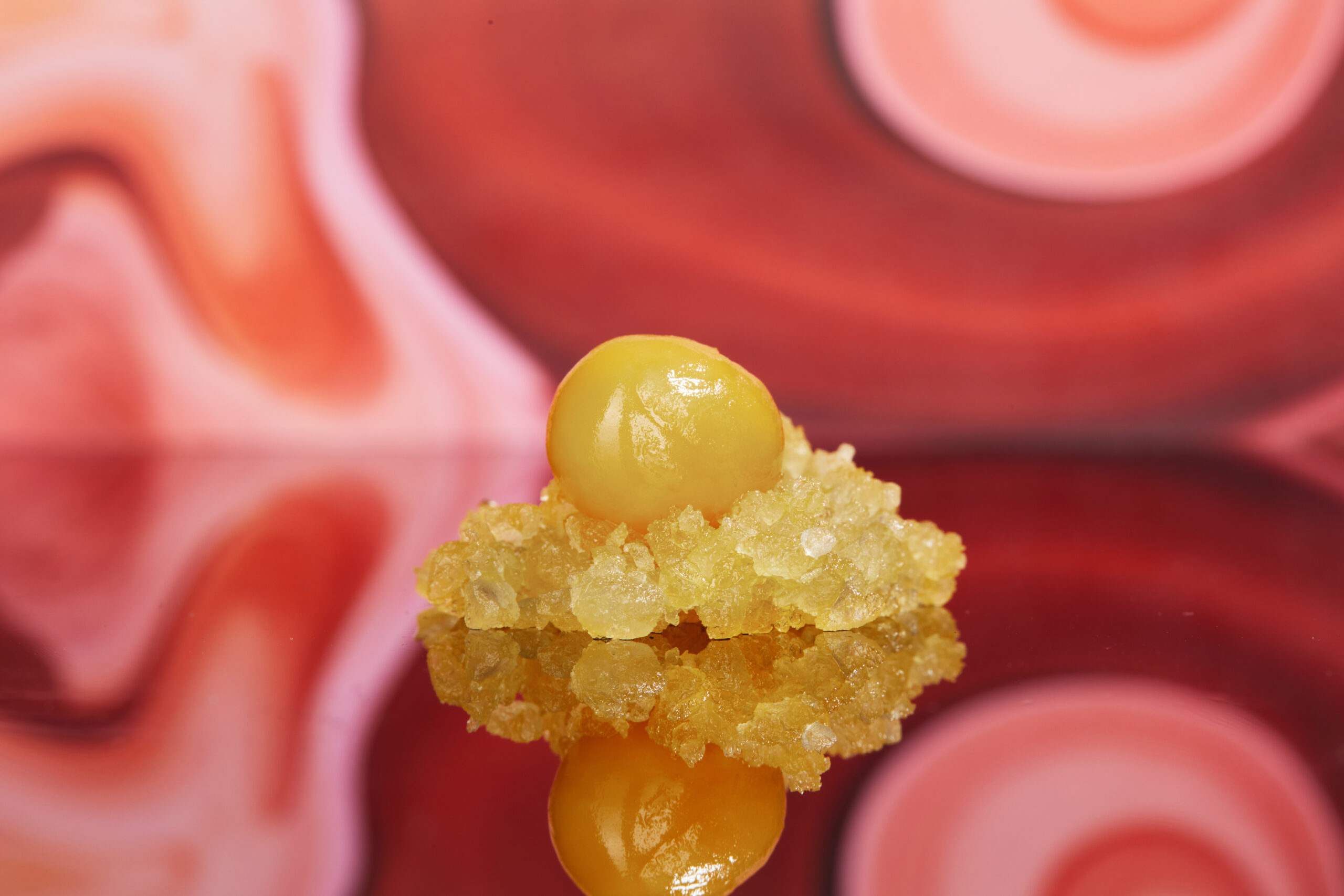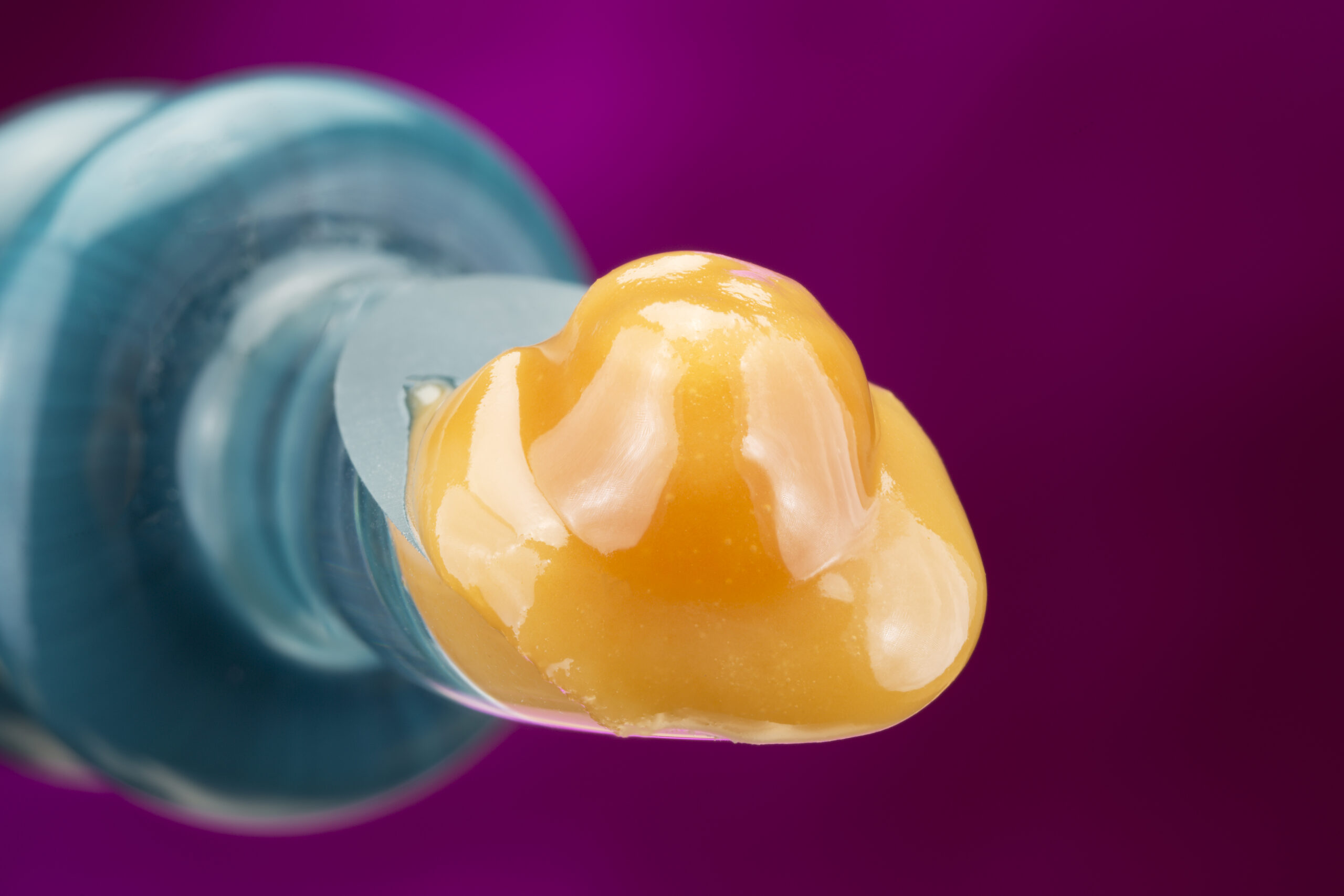Rising in popularity as new methods of cannabis consumption become more widespread, live resin is a fresh and flavorful option for both newcomers and seasoned tokers looking for quality concentrates. Learn more about this unique product and the many forms it can take.
What is live resin?
Live resin is a form of cannabis concentrate produced using fresh frozen material as opposed to dried and cured buds. This extraction method releases cannabinoids while retaining the terpenes and allows the extractor to capture the flavor of the live plant over the characteristics of dried and cured buds.
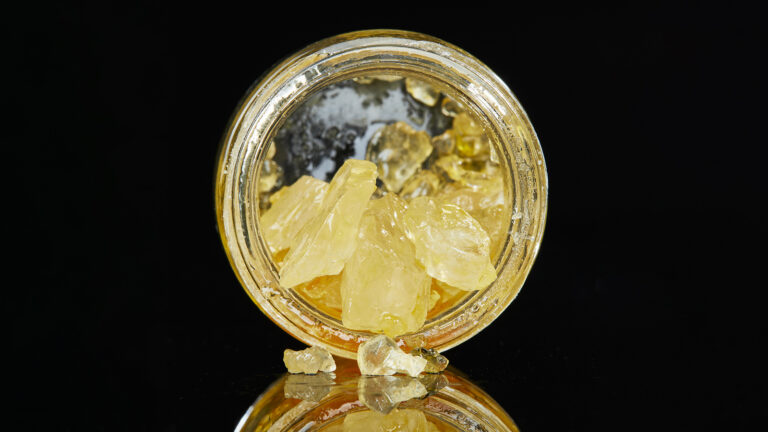 Photo by: Gina Coleman/Weedmaps
Photo by: Gina Coleman/WeedmapsImage lightbox

Since these flavorful terpenes remain intact, live resin is considered a high-quality, connoisseur-level product.
The history of live resin is short yet bountiful:
- 2010: William "Kind Bill" Fenger started the first legal grow operation dedicated exclusively to producing concentrates in Colorado. He considered the idea of producing extracts from freshly harvested cannabis plants with richer aromas and flavors, rather than extracts made with cured nugs.
- Initial attempt: Fenger created live resin with the Original Diesel cultivar using flash-frozen plant material to produce BHO. The resulting extract is flavorful and aromatic but has a low yield, is dangerous to make, and is aesthetically unappealing.
- 2013: Jason "Giddy Up" Emo installed an EmoTek Labs OBE-Dos extraction unit at A Cut Above, a medical dispensary in Colorado Springs. Fenger is hired as a consultant for technical support, leading to a collaboration.
- The collaboration: Fenger and Emo worked together for over a month, experimenting with various strains and extraction techniques using the OBE-Dos unit.
- First successful batch: Fenger and Emo produced a successful live resin batch using whole cannabis plants that had been flash-frozen, which achieved the desired aromatic and flavor characteristics. They name both the extraction process and the resulting concentrate live resin.
How to consume live resin
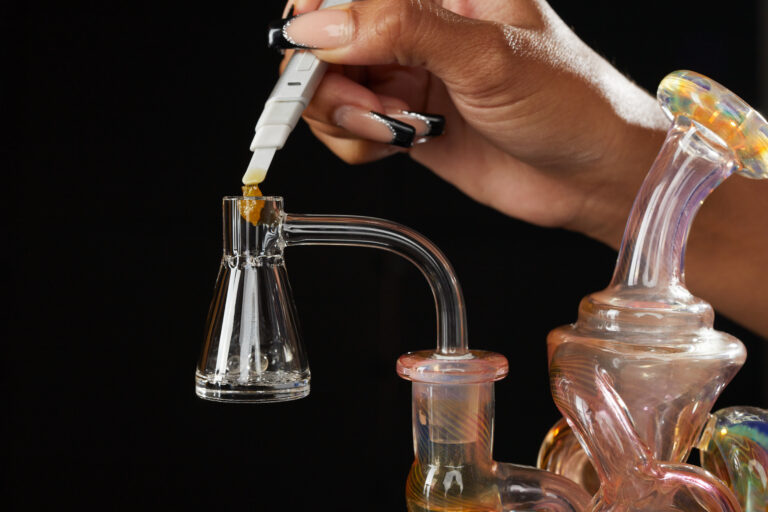 Photo by: Gina Coleman/Weedmaps
Photo by: Gina Coleman/WeedmapsImage lightbox

Live resin is a flexible cannabis concentrate that you can consume in various ways:
- Vaporizing: You can use vaporizers or dab pens designed for cannabis concentrates. These devices heat the live resin to a specific temperature, turning it into a vapor that you inhale. You can also dab the concentrate with a rig or e-nail.
- Flower: Some drizzle live resin on top of a packed bowl or incorporate it into a joint or blunt. This method enhances the potency and flavor of the cannabis flower, but may not provide the same level of terpene preservation as dabbing or vaporizing.
- Infused into edibles: You can add live resin to food to make edibles, but note that infusing live resin into brownies, gummies, or chocolates requires decarboxylation to activate the THC and other cannabinoids. Some brands, like Kiva, make live-resin-infused gummies if you prefer to go the store-bought route.
- Infused into tinctures or topicals: You can infuse decarboxylated live resin into a carrier oil or alcohol to create tinctures or topicals. Consume tinctures sublingually or orally via food and beverages. Apply topicals directly to your skin for potential localized relief.
Benefits of live resin
The ease of the live resin process is a benefit to growers. Since live resin is first fresh frozen from buds that don't need dried or cured, they can skip the time-consuming steps needed to create other forms of concentrate.
 Photo by: Gina Coleman/Weedmaps
Photo by: Gina Coleman/WeedmapsImage lightbox

Live resin is one of the most flavorful forms of concentrate since the result is flush with cannabinoids, trichomes, and terpenes. These elements remain intact, and closely resemble the taste of the starting fresh bud material. The extraction process also makes for a higher potency end product suitable for recreational and therapeutic consumers alike.
How to make live resin
Warning: Only licensed professionals should perform the manufacturing of live resin since this process can be extremely dangerous. The following information on how live resin is made is for educational purposes only.
If you'd like to make your own concentrates at home, consider making your own rosin or ice water hash in place of live resin.
Step 1: Harvest and flash-freeze
Extractors harvest the cannabis plants at peak maturity, then immediately flash-freeze them to preserve the terpene and cannabinoid profiles. The plant material is kept frozen throughout the entire extraction process.
Step 2: Prepare equipment
Professionals then prepare the extraction equipment — such as a closed-loop extraction system — which is designed to contain and recycle solvents during the extraction process. This reduces the risk of accidents and solvent loss.
Step 3: Grind herb
Extraction techs break down the frozen plant material into smaller pieces, being careful not to thaw it in the process. This increases the surface area and makes the extraction process more efficient.
Step 4: Pack the column
Extractors load the ground, frozen plant material into the extraction column of a closed-loop system.
Step 5: Introduce solvents
Extraction techs introduce a solvent — typically butane or a butane/propane mix — into the extraction system. The solvent passes through the frozen plant material, dissolving the cannabinoids, terpenes, and other compounds.
Step 6: Collect solvent mixture
Extractors collect the solvent which, at this step, is carrying the extracted compounds. The solvent is still in a liquid state due to the low temperatures.
Step 7: Purge solvent
Extractors have to purge the mixture of extracted compounds and solvent of any residual solvent. They use a vacuum oven, which heats the mixture at a low temperature and creates a vacuum to help evaporate the remaining solvent. This step may take several hours or days.
Step 8: Collect and store live resin
Once they've purged the live resin of any residual solvent, they store it in an airtight container to preserve its terpene profile and potency.
How to store live resin
Proper storage of live resin is essential to maintain its potency, flavor, and aroma.
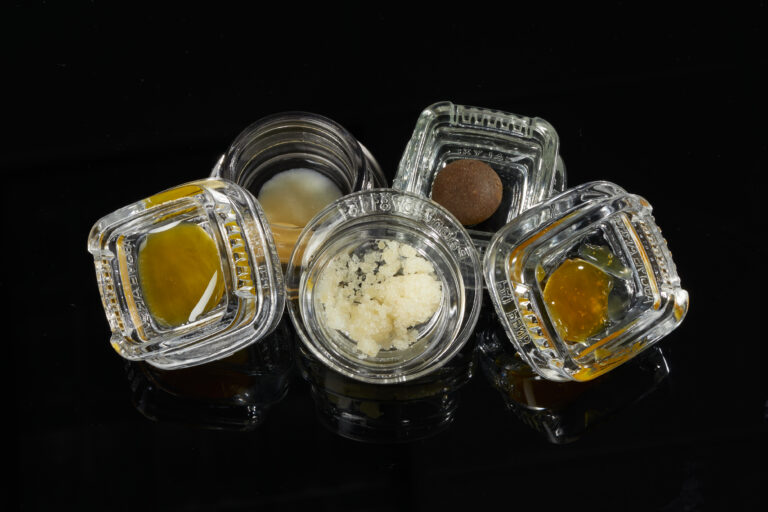 Photo by: Gina Coleman/Weedmaps
Photo by: Gina Coleman/WeedmapsImage lightbox

Here are some tips for storing live resin:
- Use an airtight container. Store live resin in an airtight container, such as a silicone, glass, or UV-resistant plastic container. These containers help prevent exposure to air, which can cause the live resin to degrade over time.
- Store it in a cool, dark place. Keep the live resin container in a cool, dark place away from direct sunlight or heat sources. Light and heat can break down cannabinoids and terpenes, reducing the potency and altering the flavor of the live resin. A cupboard, drawer, or dedicated storage box is a good choice for storage.
- Consider refrigeration. For long-term storage — or to preserve the terpene profile even better — consider storing live resin in the refrigerator. However, be cautious about temperature fluctuations when removing it from the fridge, as condensation can form and introduce moisture into the concentrate. Allow the container to reach room temperature before opening it to minimize this risk.
- Avoid excessive handling. Minimize handling of your live resin to prevent contamination and degradation. Use a dab tool when consuming it to avoid introducing oils or dirt from your hands into the concentrate.
FAQ
How is live resin different from other concentrates?
Live resin is a type of cannabis concentrate that is distinct from other concentrates due to its starting material, extraction process, and resulting characteristics.
Here's how live resin differs from other common concentrates:
- Starting material: Live resin is made from fresh, flash-frozen cannabis plants. This contrasts with other concentrates, which are often made from dried and cured cannabis plants.
- Terpene preservation: Flash-freezing the starting cannabis plant material helps preserve the plant's terpene profile. Terpenes are responsible for the aroma and flavor of cannabis. Many other concentrates lose a significant amount of terpenes during the drying and curing process, resulting in a less vibrant flavor and aroma compared to live resin.
- Extraction process: Live resin is extracted using a solvent — usually butane or CO2 — while the plant material is still frozen. This method helps capture a more complete range of cannabinoids and terpenes, creating a product that is closer to the original plant's chemical profile.
- Consistency: The most common consistencies of live resin are sauce, budder, crumble, shatter, and diamonds.
- Flavor and aroma: Due to its high terpene content, live resin often has a more intense and complex flavor and aroma compared to other concentrates. Consumers frequently report that live resin provides a more authentic representation of the cannabis plant's unique taste and smell.
- Potency: While live resin is highly potent, its potency may be slightly lower than some other concentrates, such as distillate, which can have THC or CBD concentrations exceeding 90%. This is because live resin prioritizes terpene preservation, whereas distillate focuses on isolating specific cannabinoids.
Is live resin considered a 'full-spectrum extract?'
Short answer: sometimes.
Full-spectrum extracts strive to encompass the complete range of cannabinoids and terpenes found in the natural cannabis plant. Live resin, obtained through specific processing methods, can be classified as a full-spectrum extract. However, it is important to note that not all full-spectrum extracts are derived from freshly harvested or frozen plant material. Kief, for example, is a full-spectrum concentrate, but it's collected through cured, rather than fresh, cannabis.
What does the “live" in live resin mean?
The "live" in live resin refers to the fresh cannabis plant material used in the extraction process. Extractors harvest and immediately flash-freeze the cannabis flower to preserve its terpenes, cannabinoids, and other active compounds. This flash-freezing technique helps maintain the plant's original flavor, aroma, and potency, which can be lost or diminished during a more traditional drying and curing process.
Why does live resin skip the drying and curing process?
Using fresh cannabis plant matter with a rich terpene profile to make live resin results in more floral, fruity, and spicy flavors compared to concentrates made with nug run or trim run cannabis.
What does live resin look and feel like?
It depends on the type of cultivar, or strain, used for the extract. Live resin contains a higher concentration of terpenes compared to other concentrates. With the additional essential oils, the consistency is typically looser compared to other types of concentrates. The higher the terpene content, the thinner and more flexible the concentrate becomes. The typical textures of live resin include sap, sugar, badder/budder, and sauce.
Is live resin dangerous?
No, but it also depends. As long as you purchase products from a licensed producer in a legal market, the live resin will be safe to consume. Because you are purchasing a regulated product, it ensures that the live resin meets all state-mandated health requirements. When it comes to live resin, the solvents used to create it must be purged and can only contain a certain level of residual solvents.
Can you vape live resin?
Yes, you can vape live resin. Dabbing is the most intricate vaping option, as it necessitates the use of more equipment and effort. If you prefer a simpler way to indulge in live resin, try using a nectar collector, which is a more convenient and portable version of a dab rig.
The easiest method, by far, is to use a vape pen with a live resin cartridge. Just purchase the cart, connect it to a compatible battery, and you're ready to go.
Live resin carts vs. normal carts: what's the difference?
The main difference between live resin carts and normal carts is the product used to fill the vape cartridges. Since live resin is made in a way that preserves the terpene profile of the plant it is harvested from, the carts tend to have increased flavor, aroma, and potency compared to normal carts. This also means they tend to cost more than normal carts.
How much does live resin cost?
In general, expect to pay more for live resin than other types of concentrates. Differences in specific locations and market fluctuations make it difficult to pin down an exact price. Higher-end live resin can run close to $100 per gram and up, while the average nationwide seems to be between $35 and $80 per gram.
What's the difference between live resin and sauce?
The distinction lies in the initial plant material used. Live resin is exclusively made from freshly harvested cannabis plants that undergo flash-freezing.
On the other hand, sauce can be derived from either fresh plant matter or cured buds, but the latter will not process the same abundance of terpenes as live resin. To determine the type of sauce, carefully inspect the packaging and labels for indications of whether it is made from cured nug sauce or live resin sauce.
What's the difference between live resin and live rosin
Both concentrates have a high cannabinoid content and provide powerful and distinct experiences. Ultimately, the difference between live resin and live rosin comes down to the extraction process:
- Live resin is extracted with chemical solvents to produce a potent, amber-colored concentrate that packs a punch on terpenes and flavonoids.
- Live rosin is extracted in a solventless or chemical-free manner and may appeal to those who want to avoid the possibility of chemicals in their concentrate. However, because of this slightly lengthier process, prices tend to be a little higher for live rosin.
Live resin vs. distillate vs. cured resin: what's the difference?
Live resin, cured resin, and distillate are all cannabis concentrates, but they differ in the extraction process, the starting material, and the final consistency, flavor, and potency.
Here's a simple chart breaking down the differences:
| Concentrate | Starting material | Extraction process | Characteristics | Average potency |
| Live resin | Fresh, flash-frozen cannabis plants | Solvent-based (usually butane or CO2) | High terpene content, vibrant flavor and aroma, runny, sap-like consistency | High potency, slightly lower than distillate |
| Cured resin | Dried and cured cannabis plants | Solvent-based (usually butane or CO2) | Less vibrant flavor and aroma than live resin, varying consistency (shatter-like, wax, crumble) | High potency, terpene content may be lower than live resin |
| Distillate | Various cannabis extracts or raw plant material | Multi-step process: extraction, winterization, decarboxylation, short-path distillation | Virtually odorless and flavorless, no terpenes, thick oil-like consistency, highly refined | Extremely high potency, THC or CBD concentrations often exceeding 90%, no terpenes |
Featured image by Gina Coleman/Weedmaps

